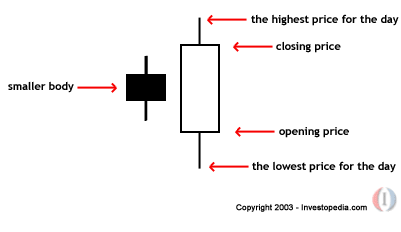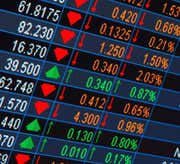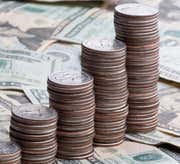SOURCE:https://www.investopedia.com/ask/answers/010715/what-are-most-common-bullish-patterns-used-traders.asp
A:

Read more: Bullish Engulfing Pattern https://www.investopedia.com/terms/b/bullishengulfingpattern.asp#ixzz5AJwLPjeH
Follow us: Investopedia on Facebook
Read more: Piercing Pattern https://www.investopedia.com/terms/piercing-pattern.asp#ixzz5AJxSYDuc
Follow us: Investopedia on Facebook
There are several key bullish candlestick patterns that traders commonly use as signals to either enter buy trades or close out existing short positions. While it's impossible to pinpoint one as the most popular, outlined below are some of the bullish patterns most often noted by market analysts.
Bullish Engulfing Pattern
The bullish engulfing pattern is almost universally recognized as a bullish reversal signal by traders of stocks, futures and forex. It is often the basis for adopting a trade position. The pattern consists of two candlesticks. The first is a down candle with at least a moderate-length body; it cannot be a doji candle with identical open and close. The second is an up candle with a body that completely engulfs the body of the first candle, opening below the first candle's close and closing above the first candle's open. The pattern is considered stronger when the second candle completely engulfs the body of the first candle and the first candle's entire range.
Source: https://www.investopedia.com/terms/b/bullishengulfingpattern.asp
What is a 'Bullish Engulfing Pattern'
A bullish engulfing pattern is a chart pattern that forms when a small black candlestick is followed by a large white candlestick that completely eclipses or "engulfs" the previous day's candlestick. The shadows or tails of the small candlestick are short, which enables the body of the large candlestick to cover the entire candlestick from the previous day.

Next Up
BREAKING DOWN 'Bullish Engulfing Pattern'
As implied in its name, this trend suggests the bulls have taken control of a security's price movement from the bears. This type of pattern usually accompanies a declining trend in a security, suggesting a low or end to a security's decline has occurred. However, as usual in candlestick analysis, the trader must take the preceding and following days' prices into account before making any decisions regarding the security.
Bullish engulfing candles indicate immense buying interest that swallows the range of the prior candlestick low and surpasses the candlestick highs. The buying action is frenzied as the candle usually closes at its highs with little to no upper wick. This in turn triggers more buyers who spill over into the next candle. If the next candle closes higher than the bullish engulfing pattern, the next leg of the uptrend usually forms.
Bullish Engulfing Candle Reversals
Where a bullish engulfing candle forms in the context of a trend is one of the most important factors. When a bullish engulfing candle forms at the end of a downtrend, the reversal is much more powerful as it represents a capitulation bottom. The lows of the candle should be the low of the downtrend. This is usually preceded by a minimum of four consecutive lower low candles prior to the bullish engulfing candle, which should close near the candle highs. When the next candle closes above the bullish engulfing candle, it forms a market structure low trigger, which is the high of the proceeding candlestick. When that high is broken, then an official trend reversal forms.
For example, if XYZ is in a downtrend that has shown five consecutive lower candle closes at 25.20, 25, 24.80, 24.70 and 24.60, then it forms a bullish engulfing candle with a low of 24.30 that bounces and closes at 24.80. The next candle has a high of 25 and closes at 24.95. This sets up the market structure low trend reversal trigger if 25 can break, which is the high of the prior candle. In this case, the stock breaks 25 to trigger a surge that spikes the stock up to 25.30 and reverses XYZ back into an uptrend. The bullish engulfing candle reversal is much stronger than a typical hammer type reversal since the body completely engulfs the prior candle indicating a buying frenzy.
RELATED TERMS
RELATED ARTICLES
RELATED FAQS
Read more: Bullish Engulfing Pattern https://www.investopedia.com/terms/b/bullishengulfingpattern.asp#ixzz5AJwLPjeH
Follow us: Investopedia on Facebook
****
Piercing Pattern
The piercing pattern is another two-candlestick pattern that is very similar to the bullish engulfing pattern. The first candlestick in this pattern is a long down candle that closes near its low. The second candlestick gaps lower on open, but it closes higher than the halfway point of the first candle's body. The shadows on both candlesticks are usually small and not considered especially significant. The key element of this candlestick formation is that, like the bullish engulfing pattern, it shows a definitive shift from selling pressure to buying pressure.
Source:
https://www.investopedia.com/terms/piercing-pattern.asp
DEFINITION of 'Piercing Pattern'
A technical trading signal that is marked by a closing down day with a good-sized trading range, followed by a trading gap (drop) lower the following day that covers at least half of the upward length of the previous day's real body (the range between the opening and closing prices), and then closes up for the day. A piercing pattern often signals the end of a small to moderate downward trend.
Next Up
BREAKING DOWN 'Piercing Pattern'
A piercing pattern can serve as an indicator that it is time to either buy a stock or close out short positions because the stock may be trending upward soon. It should not, however, be used as a stand-alone indicator, but should be compared against other bullish and bearish indicators.
Read more: Piercing Pattern https://www.investopedia.com/terms/piercing-pattern.asp#ixzz5AJxSYDuc
Follow us: Investopedia on Facebook
****
Hammer Up Pattern
The hammer up pattern is formed by a single candlestick with a small body, a long shadow on the bottom side and a very small topside shadow. Ideally, the lower shadow should be at least two times the length of the candle body, made up of one candlestick, white or black, with a small body, long lower shadow, and a small or nonexistent upper shadow. The lower shadow should be at least twice the length of the body, and the high/low range should be relatively large.
What is a 'Hammer'
A hammer is a price pattern in candlestick charting that occurs when a security trades significantly lower than its opening, but rallies later in the day to close either above or near its opening price. This pattern forms a hammer-shaped candlestick, in which the body is at least half the size of the tail or wick.
Next Up
BREAKING DOWN 'Hammer'
A hammer occurs after a security has been declining, possibly suggesting the market is attempting to determine a bottom. The signal does not mean bullish investors have taken full control of a security, but simply indicates that the bulls are strengthening.
Psychology of Hammers
Hammers signal a capitulation by sellers to form a bottom accompanied by a price rise, to indicate a potential reversal in price direction. Hammers are most effective when they are preceded by at least three or more consecutive declining candles. Declining candles are indicated with lower low tails. This means prices reach a lower price than the low of the prior candle period. This illustrates the continuation of fear and selling pressure by participants feeling the pain of declining prices. Eventually, the pain becomes too great and forces the remaining sellers to panic out of their positions in a final selling frenzy, indicated by the lowest price being reached, followed by a quick rebound from the lowest price to close the candlestick with a small body. The tail should be at least twice the size of the candlestick body. It should look similar to a capital 'T'. This indicates the potential for a hammer candle. Note the term "potential."
Hammer Confirmation
The true confirmation of the hammer candle can only be made when the very next proceeding candle closes with a higher low than the hammer candle. This confirms the capitulation from sellers, as buyers have determined the price is too attractive to pass up and quickly buy into the position. When the proceeding candles continue to consecutively form higher lows, it indicates that the buyers are now supporting the pullbacks buy and bidding up shares. As the price rises higher, it can also cause earlier sellers to reconsider and buy back into the stock or other financial instrument. One thing to remember is that the buyers may not actually be bullish on the stock.
In fact, early buyers can often be composed of short-sellers who must actually buy shares in order to cover their short positions and lock in profits when a hammer candle forms. As the price continues to recover, it can also cause late short-sellers to re-evaluate their short positions as earlier profits turn into losses. Hammers can be measured on any times frame candlestick chart. The larger the time frame chart, the more thorough the hammer candlestick will be, due to the more participants involved.
RELATED TERMS
RELATED ARTICLES
RELATED FAQS
Read more: Hammer https://www.investopedia.com/terms/h/hammer.asp#ixzz5AJyGdXcM
RELATED FAQS
RELATED ARTICLES
RELATED TERMS
HOT DEFINITIONS
Trading Center
Read more: What are the most common Bullish patterns used by traders? | Investopedia https://www.investopedia.com/ask/answers/010715/what-are-most-common-bullish-patterns-used-traders.asp#ixzz5AJvHkiWJ
Follow us: Investopedia on Facebook
 SHARE
SHARE
















No comments:
Post a Comment